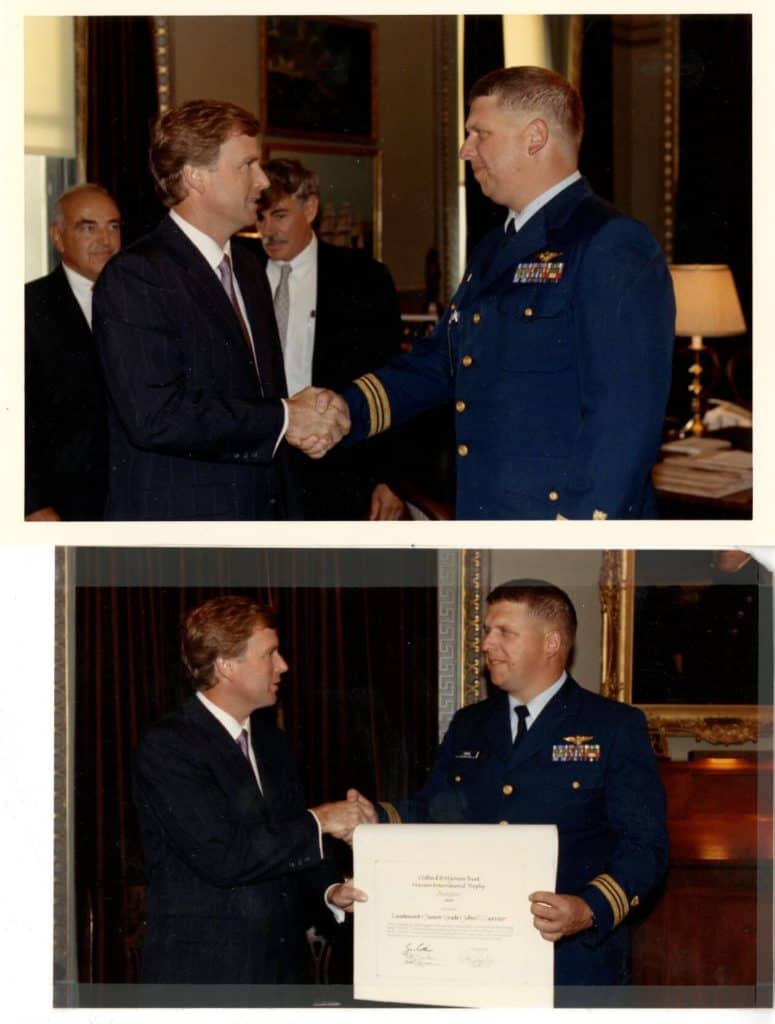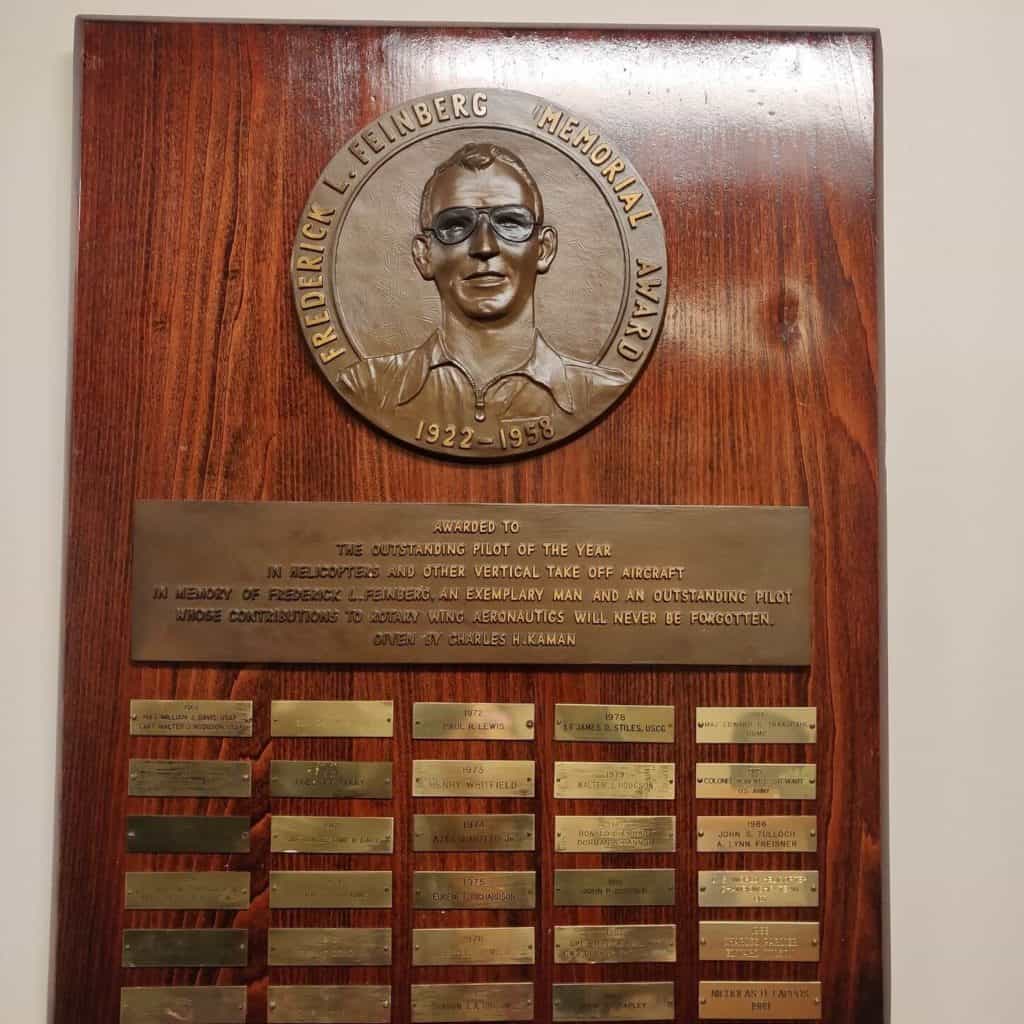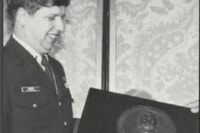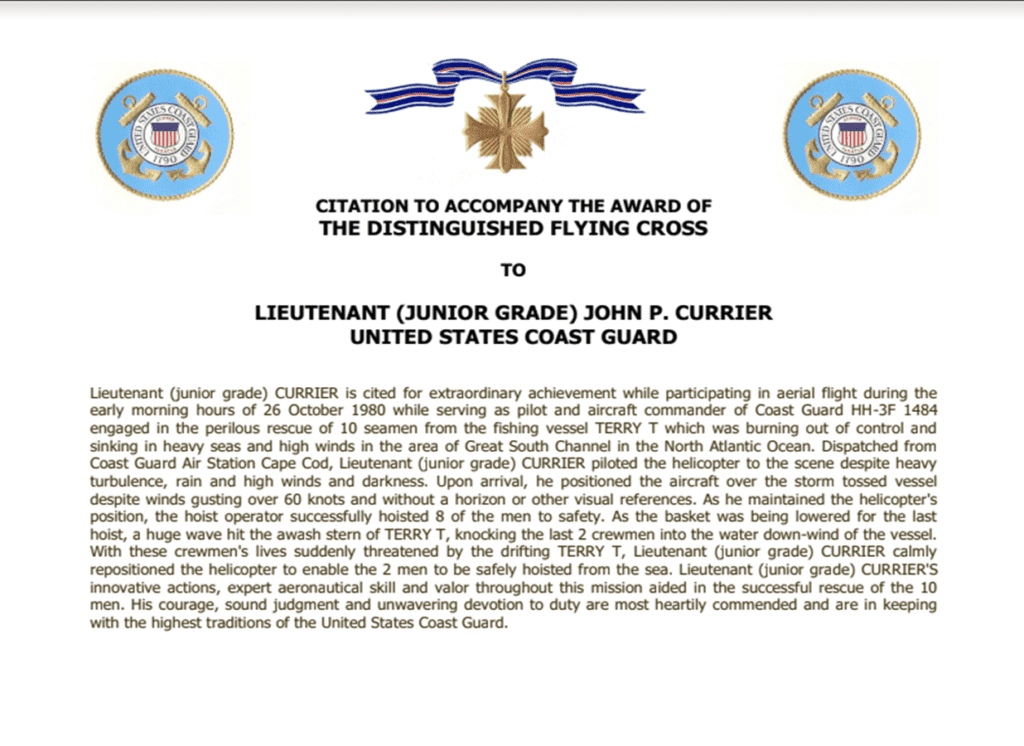By Sean M. Cross, CAPT, USCG (retired)
“As the basket was lowered a fifth time to pick up the two remaining men, a huge wave hit the awash stern of the TERRY T knocking the last two crewmen – the master and the engineer – into the water downwind of the helicopter and the ship. With the lives of the two crewmen suddenly threatened by the turbulent seas and the ship drifting down upon them…”
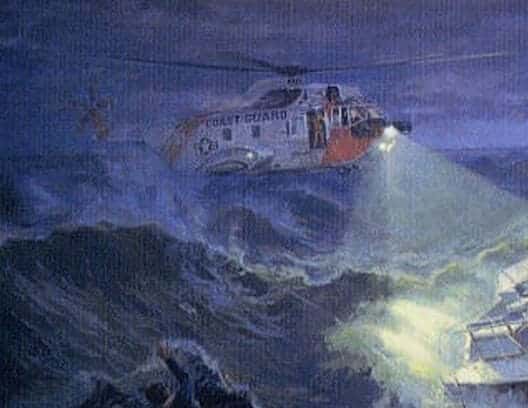
TODAY IN COAST GUARD AVIATION HISTORY – 26 OCTOBER 1980: HH-3F #1484 assigned to Air Station Cape Cod, MA and crewed by LTJG John P. Currier (AC); LTJG Robert L. Abair (CP); AM1 David L. Seavey (FM) and AE2 Gordon R. Warren (AV) was launched at 3:40 AM in response to the 110-foot fishing vessel “TERRY T” out of New Bedford sinking with 10 crewman aboard. The eastern-rigged scallop trawler was 80 miles southeast of Nantucket in 30-foot seas, blowing snow and 60-knot winds gusting to 80 knots. The TERRY T reported “4-feet of water in the engine room”i and requested dewatering pumps to help control the flooding.ii

“We got three pumps going but we couldn’t contend with the water,” Farland said.vi
In the interim, the Terry T had been in frequent radio contact with the Coast Guard through the Nantucket Lightship and by 3:30 AM had informed the Coast Guard they would have to evacuate.vii
Currier, the most junior Aircraft Commander at the unit, noted he “got stuck” with duty that night because there was a Wardroom party planned. It turned into a busy night. The #1484 aircrew had already flown on several SAR cases that evening including evacuating three Coast Guard members from the Buzzards Bay Entrance Light due to structural concerns caused by the adverse weatherviii . Currier described their return to base from the last case, “We went back into the air station and I remember shooting the instrument approach at 120 knots indicated airspeed and doing less than 20 knots over the ground.” He added, “We came in, landed and taxied into the lee of the hanger to shut the rotor head down and those guys were taking care of the post-flight and my wife was at the wardroom party. So when we got back to the wardroom at about 8 o’clock at night she said ‘You’re not going out again are you?’ and I said ‘No way – nobody’s out there.’ix
About 3:40 in the morning the aircrew was awakened by Rescue Coordination Center (RCC) Boston saying there was a scalloper taking on water and unable to control flooding about 80 miles southeast of Nantucket. The aircrew described it as an interesting launch because it was still blowing 60 knots (which exceeded the main rotor start limit) – so the duty crew dragged the helicopter about halfway out of the hangar to start the turbine engines and engage the rotor system. They did it in this manner because when a helicopter first starts, the rotors are flexible and droop down under their own weight. Strong winds can cause the blades to flap up and down when they are at a slow RPM causing them to contact the tail boom or fuselage and do serious damage.
#1484 took off and flew toward the last known position (LKP) about 15 miles east of the Nantucket Lightship under instrument flight rules (IFR) – flying in the clouds with limited to zero visibility, navigating only by reference to the cockpit instruments. The aircraft experienced severe turbulence and Currier remarked, “The crew was holding on for dear life”.x

At 4:54 AM, #1484 was approaching the TERRY T’s LKP and Currier further described the situation as “Pitch black except for the lightning and there was sleet – so we were concerned about icing”. Helicopter pilots avoid icing like dental work. When ice forms on rotor blades, they lose their ability to provide lift, and the aircraft can no longer maintain flight. The aircrew contacted TERRY T on the radio and confirmed they still desired dewatering pumps – they concurred and reported that the fishing boat had lost steering and “was at the mercy of the thirty-foot seas and fifty-knot winds”xi. However, the master came on the radio a few minutes later as #1484 was inbound and said “We got a fire in the engine room, we can’t control it and I want everybody off – there are 10 of us”.
As the water level rose it produced short circuits that caused spontaneous fires in the boat’s electrical system. Farland said the crew used four fire extinguishers and had nothing left with which to fight the fires. Then radio contact was lost.xii From their transit altitude, the aircrew performed an instrument approach to the water astern of TERRY T.xiii The crew used a PATCH or Precision Approach to a Coupled Hover, an autopilot maneuver that transitions the helicopter from forward flight in the clouds down to an automatic hover at 50 feet visual with the water.xiv This maneuver can be disorienting in the clouds at night, particularly when low over the water with little room for error. Both pilots must continuously scan and interpret the flight instruments – this is critically important – to confirm the autopilot is flying the correct profile. This maneuver was described as “dicey” due to the HH-3F’s unreliable doppler. The aircrew finally made visual contact with the trawler’s glow as the aircraft descended below 150 feet.
Currier described the challenging situation, “When we arrived in a hover, we turned on the floodlights and neither myself, nor the co-pilot, nor the flight mechanic thought we could do it. The tops were blowing off the waves and going over the boat and the boat was dead in the water so it was in the trough – so it was rolling more than rail-to-rail – it was getting green water over each rail as it rolled.”xv With the helicopter pointing into the strong westerly winds – TERRY T’s “bow was pointed to the right (the aircraft 3 o’clock position), so I had no place to go to hoist” added Currier.xvi Seavey had similar sentiments, “This case was the only time that I had thoughts that I might not be able to complete the hoists [due to] the combination of high winds 50-60 knots or so and 25-30 foot seas.”xvii The aircrew was concerned with the extreme pitch and roll of the fishing vessel and the height of the rigging and other obstacles, so they initially requested that the TERRY T crew disembark the vessel to the life raft. However, when the fishermen inflated the raft, it immediately blew overboard.xviii After careful assessment, they decided that hoisting from about 40-feet above the highest waves to an area just aft the pilot house was their best chance for success.
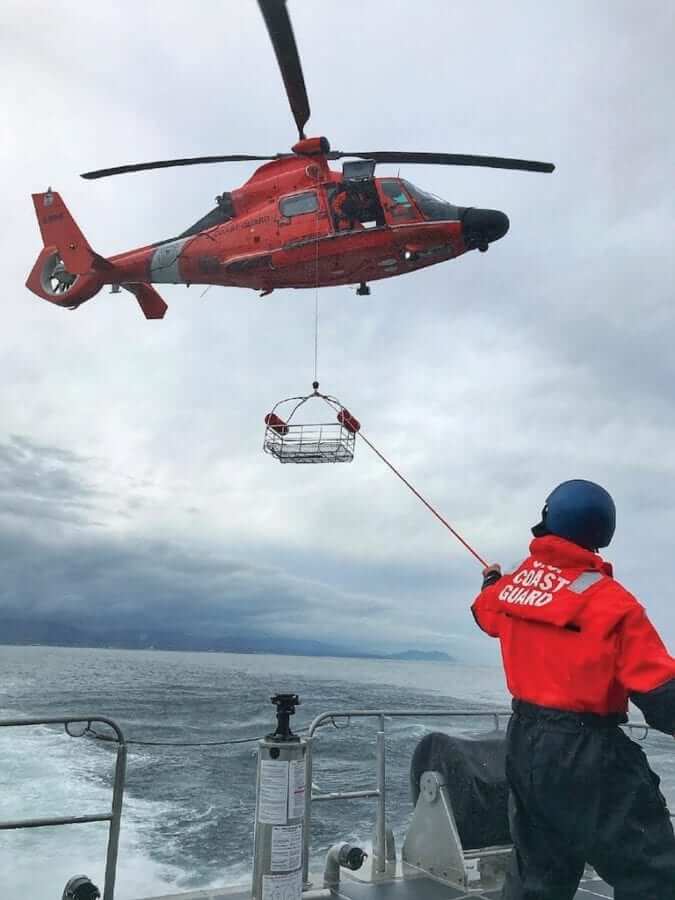
With no suitable hover reference, Currier was guided only by the voice of his hoist operator, David Seavey. Initial attempts did not go well. The pilot is typically unable to see the hoist area (below and aft of the pilot seat) and must fly exclusively off the flight mechanic’s conning commands – this can be very challenging when the sole hover reference is a raging and turbulent sea surface of 30-35 foot swells. The crew was convinced that a ‘trail line hoist’ was the right tool for the situation as it would allow the helicopter to hoist from a position offset 30-40 feet from the boat and facilitate Currier’s use of the bobbing fishing vessel as a hover reference. A trail line is a 105-foot piece of polypropylene line (similar to a water ski rope) with a 300-pound weak-link at one end and a weight bag at the other. The weight bag end of the trail line is paid out below the helicopter and delivered to the persons in distress (usually vertically, but seasoned flight mechanics can literally ‘cast’ the weight bag to a spot). The weak link is then attached to the hoist hook and the helicopter backs away until the pilot can see the hoisting area. The persons in distress can then pull the basket to their location – creating a hypotenuse or diagonal – as opposed to a purely vertical delivery.
This was great in theory, but not in practice as Seavey said, “The high winds caused the trail line delivery, even with the heavy weather weight bags (25 pounds) to sail aft and twice get fouled in the rigging. We backed off, discussed the situation and decided to try using the Danforth anchor -which worked.”xix Being an amphibious helicopter, the HH-3F kit included a Danforth anchor (similar to any small recreational boating anchor) with a half-inch line – they used this as an improvised trail line and it worked perfectly – with one exception which would trigger problems later in the evolution.xx
Currier was now able to use the vessel’s radio antenna and momentary glimpses of the superstructure for visual reference.xxi Seavey conducted four hoists with assistance from Warren, taking crewman in the basket two-at-a-time on each hoist.xxii This was unusual, but necessary due to fuel concerns, the need to hoist everyone before the trawler sank and the extreme difficulty involved in placing the basket on the vessel each time. Abair added, “While a series of ten one-man-hoist evolutions could have been successful, it would have more than doubled the difficulty of the rescue and would have likely resulted in loss of life.”xxiii Between hoists, Warren took the survivors aft in the cabin and provided them with blankets to get warm. Seavey gratefully described Warren’s efforts: “He assisted me during the hoists, was helping out without having to be told what I needed. He anticipated what I needed. He was the extra set of hands getting the rescue basket into the cabin and then clearly directed the survivors to the back of the cabin.” Often forgotten under these conditions was the superlative job done by Abair, a Direct Commission Aviator and veteran Marine Corps helicopter pilot, in his Safety Pilot role. He continuously scanned the system instruments to ensure the aircraft was operating normally and the flight instruments to ensure obstacle clearance and safe altitude – occasionally coming on the controls to assist. He conveyed critical information effectively in a very dynamic environment without interfering with Seavey’s conning commands – the crew said he did a masterful job.xxiv
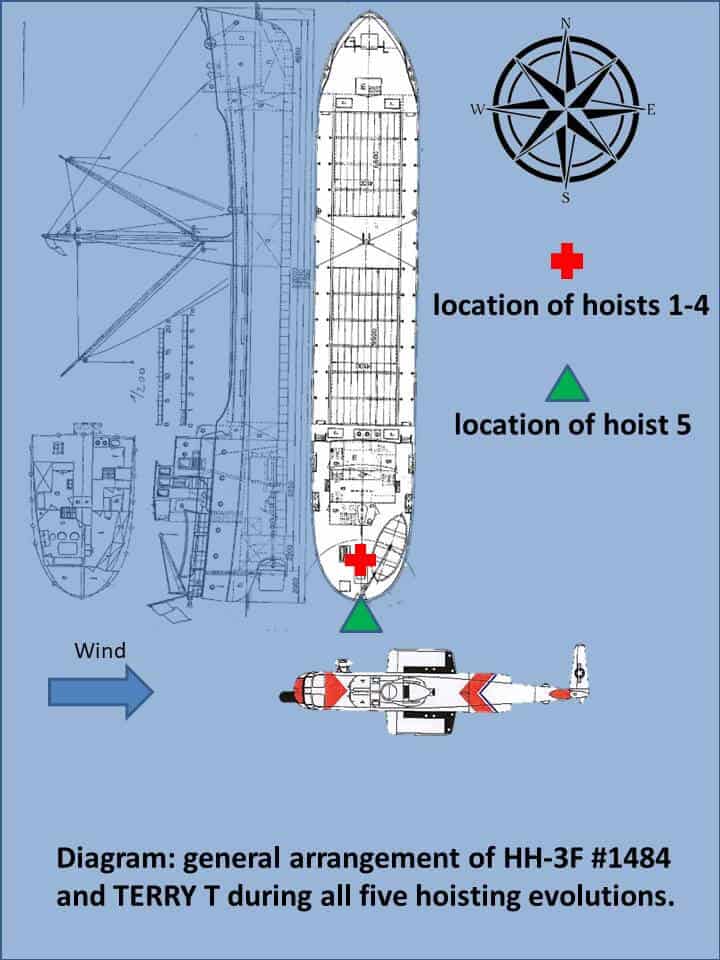
As the basket was lowered a fifth time to pick up the two remaining men, a huge wave hit the awash stern of the TERRY T knocking the last two crewmen – the master and the engineer, brothers Roland and Brian McFarland – into the water downwind of the helicopter and the ship.xxv “I had one hand on the basket and one hand on my brother,” Farland said xxvi. With the lives of the two crewmen suddenly threatened by the turbulent seas and the ship drifting down upon them, Currier had to reposition the aircraft over the two men with only the conning commands from Seavey to guide him. With Seavey’s instructions, Currier demonstrated extreme skill and daring and maneuvered the basket into a position in the water so that the two men could literally fall into it, and they were lifted to safety – or so they thought.
At this point, the boat actually started to go down by the stern, Seavey had the basket and two men about two-thirds of the way from the boat deck to the helicopter when he realized that earlier in the evolution without aircrew knowledge, the fisherman had tied the trail line off to the pilot house rail. The helicopter was connected to the boat by the anchor line. Seavey shouted “We’re tied to the boat, we have problems here”.xxvii Currier and Abair assessed the sea state then carefully descended from their hoisting altitude of 40 feet to 25 feet creating slack in the trail line and allowing Seavey and Warren to bring the basket into the door. At once, Seavey cut the anchor line with a knife and immediately conned, “Up, up, up” for the pilots to immediately pull power. At 25-feet, Seavey could see that the wave tops on either side were level with the helicopter.xxviii
After completing the hoists, it took about five minutes to secure the cabin – Seavey and Warren working together – Warren helped the Captain and crew to the rear of the cabin and then secured the basket while Seavey was securing the hoist, closing the cabin door and reporting the cabin was secured and ready for forward flight. As #1484 circled the scalloper, it had already begun to founder – the decks awash with sea water.xxix The flight mechanic and avionicsman administered first aid to the injured crew on the return flight that landed at 6:52 AM. Throughout the mission, Currier and his crew showed exemplary skill and courage. Currier stated: “We got them off and got back. The helicopter was pretty beat up – they actually had to change the tail rotor because of overstresses.”xxx
All 10 men (listed below) were saved from the TERRY T – four of the survivors were from the same family.xxxi
Roland Farland (Captain)
Elmer Beckman (Mate)
Brian Farland (Engineer)
John Santos (cook)
Donald Capps (deckhand)
George Altman (deckhand)
Ronald Charpentier (deckhand)
Stephen Farland (deckhand)
Peter Farland (deckhand)
George Johnston (deckhand)xxxii
“It was pretty hairy,” Roland Farland said. “I just have to highly commend the Coast Guard for doing such a terrific job.” “It was blowing good,” the New Bedford man said: “Seas were 30 feet and winds were blowing 60 to 65 miles.”
In a post-mission interview, Currier conveyed, “Visibility was about half a mile and it took us five hoists to get the 10 people off the boat. We had to hover over it for about an hour.”xxxiii “The problem with a situation like that is that you have no point of reference,” he said. “All you can see is the boat and water, and they are both in motion. You try to keep the helicopter as a stable platform, but it’s hard. I’ve been here three years and those were the worst conditions I’ve seen.”xxxiv
Thirty-five years later, an older and wiser Vice Admiral (VADM) Currier reflected on that night, “This was not a solo pilot operation. This was a reflection of an incredibly talented flight mechanic and a solid co-pilot. Actually, I think that was my co-pilot’s first rescue mission after transitioning from the Marine Corps to the Coast Guard, and I think it was a heck of an eye-opener for him.” VADM currier added, “In the Coast Guard we have some of the best rotary- and fixed-wing pilots there are. I can say that as the old Coast Guard aviator, but I’ve been around long enough in civil and military aviation to say our people are among the very best. They are challenged on a daily basis with missions that would be a big deal in other services. For us, they’re how we do business – night, off-shore, poor visibility, terrible weather. It’s always single-ship, and it’s always single-crew. It requires skill, proficiency and individual initiative.”xxxv
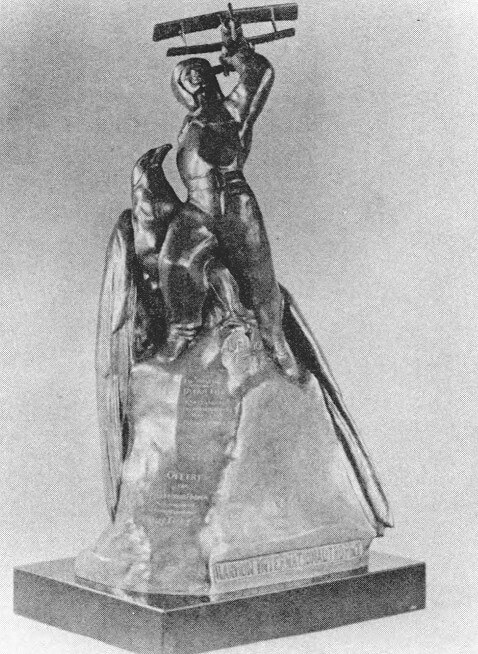
For this nearly impossible rescue, Currier earned the Harmon International Aviation Trophy – the only Coast Guard Aviator to earn this distinction. The Harmon Trophy – the aviator’s award – is given for the most outstanding international achievements in the preceding year, with the art of flying receiving first consideration. He joined other winners such as: Colonel Charles A. Lindbergh, Lt. General Jimmy Doolittle, Major Charles E. Yeager, Howard Hughes, Major Edwin E. “Buzz” Aldrin and Amelia Earhart.
The Harmon Trophy was presented to him at the Old Executive Building across from the White House by Vice President Dan Quayle on 21 June 1991 (11 years after the mission). His name is inscribed on the six foot tall trophy in a glass enclosure in the National Air and Space Museum. Interestingly, Currier was never notified regarding his selection for the award, which has historically been presented by the President. The Reagan assassination attempt by John Hinckley Jr. on 30 March 1981 wreaked havoc on the President’s schedule and the award presentation was overlooked. His parents, while visiting the Smithsonian Air and Space Museum in Washington, D.C. six years later, reportedly saw his name engraved on the trophy and asked him about it. It took another four years of action by headquarters and the Coast Guard Aviation Association before Currier received the award.
The #1484 aircrew also earned the American Helicopter Society (now the Vertical Flight Society) Frederick L. Feinberg Award in March 1981 – presented to the pilot or crew of a vertical flight aircraft who demonstrated outstanding skills or achievement during the preceding 18 months.xxxvi
The Frederick L. Feinberg Award (1961) was established by the American Helicopter Society. Presented to the pilot or crew of a vertical flight aircraft who demonstrated outstanding skills or achievement during the preceding 18 months. It honors the memory of an outstanding helicopter test pilot and an exemplary person.
LTJG Currier and AM1 Seavey both earned the Distinguished Flying Cross for this mission, while LTJG Abair and AE2 Warren earned the Coast Guard Commendation Medal with the Operational Distinguishing Device in a ceremony at Air Station Cape Cod in June 1981.xxxvii The Currier and Abair citations are below – the Seavey and Warren citations have not been located.
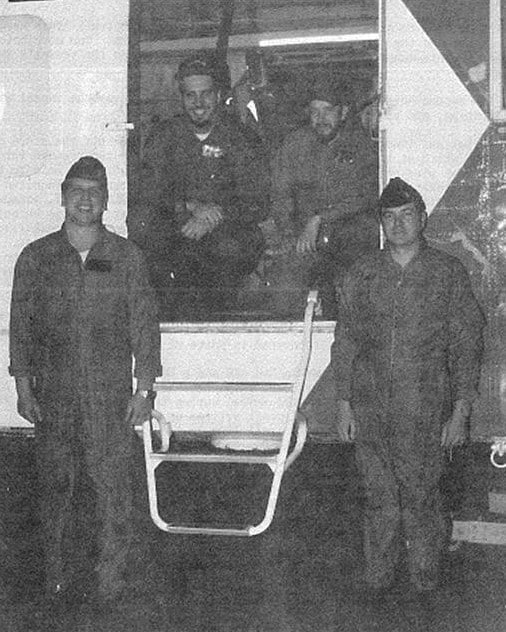
Vice Admiral John P. Currier, USCG (retired) passed away on 01 March 2020 from natural causes at his home in Traverse City, Michigan. His ashes were interred with full military honors at Arlington National Cemetery on 14 September 2021. He is recognized as the “godfather of the Coast Guard’s modern H-60 helicopter program” and received commendations for flying and rescue work over his 38-year career in the Coast Guard. He held assignments as an aviator at Air Stations Cape Cod (MA), Sitka (AK), Traverse City (MI), Astoria (OR), Detroit (MI), and Miami (FL). He held many senior leadership positions, including Chief of Operations and Chief of Staff for the Pacific Area, Commander of the Thirteenth District in the Pacific Northwest, Coast Guard Chief of Staff and finally Vice Commandant, the Service’s second in command. From 2008-2012, just prior to his tenure as Vice Commandant, the Coast Guard Aviation community experienced a horrendous series of aircraft mishaps that took the lives of 18 Coast Guard aircrewmen. This dilemma weighed heavily on Admiral Currier, but – he was the RIGHT man, in the RIGHT place, at the RIGHT time when the Service needed him most. The Service was searching for solutions – long fatigued and exasperated from attending memorial services, hearing eulogies and listening to “Amazing Grace” – he led us out of that morass to ‘clearer skies’ with new focus on cockpit leadership, proficiency, risk management and a ‘back to basics” approach when it came to tactics, techniques and procedures. He guided a structured fleet-wide operational risk assessment and directed corrective actions which yielded a remarkable improvement in aviation professionalism and safety. These efforts added to his already robust Coast Guard Aviation legacy.
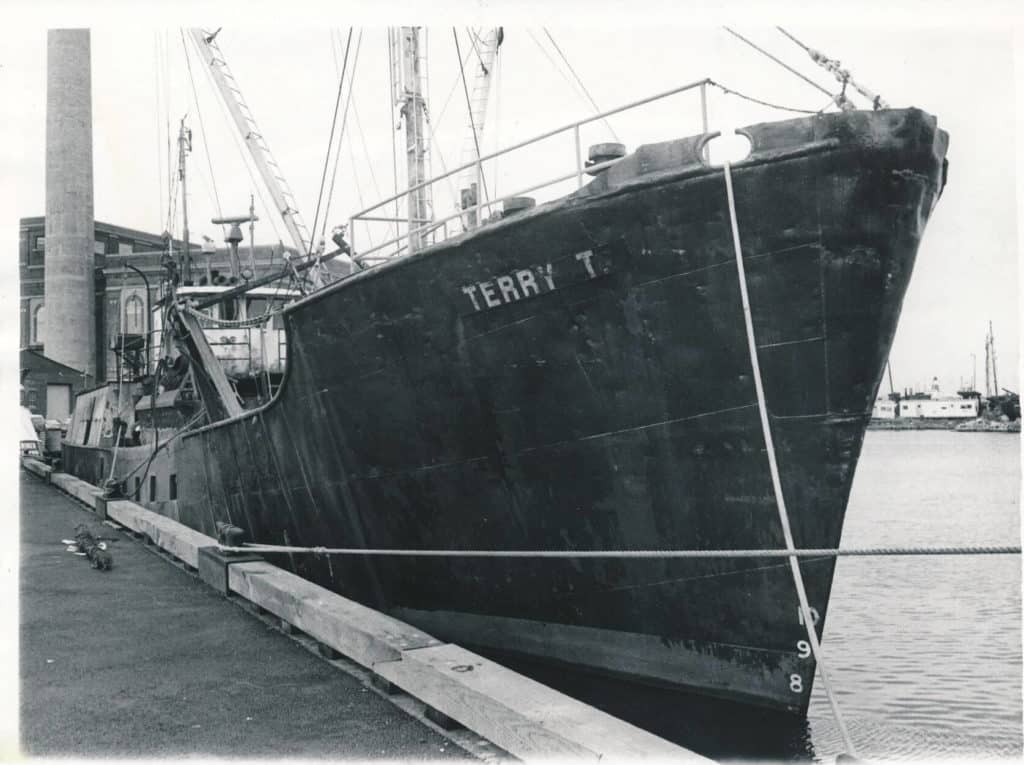
[i] Boston AP article – multiple sources – “The ‘Terry T.” of New Bedford called for help at about 3:30 a m. when its engine room filled with about four feet of water, spokesman Mario Toscano of the Coast Guard’s Boston Rescue Center said.” – available here: https://www.newspapers.com/newspage/439301890/
[ii] John Currier (HH-3F Aircraft Commander) in video discussion (Exit Interview) with Scott T. Price (Coast Guard Historian) in Washington, D.C. on April 23, 2014.
[iii] Jack Stewardson, “10 fishermen saved; 2nd trawler overdue,” The Standard-Times, New Bedford, Mass., October 27, 1980, page 1.
[iv] Photo credit – from John Asher, Roen Salvage Company
[v] Jack Stewardson, “It was pretty hairy, but help came for fishing crew,” The Standard-Times, New Bedford, Mass.,, October 28, 1980, page 4.
[vi] Ibid.
[vii] Ibid.
[viii] Gordon Warren (HH-3F Avionicsman) in phone interview with the author on September 30, 2021. Also, AD2 John “Jay” Skakle, was the duty flight mechanic for 3-4 October 1980, but injured his hand during the Buzzard Bay Entrance Light hoists and was replaced by AD1 David Seavey. Description of conditions “the tower was in about 40 feet of water and it was about 30 feet above the water that the bottom of the structure started…I don’t know the physics or the hydraulics of this thing, but I do know that the waves were banging the bottom of the structure.”
[ix] Currier interview
[x] Ibid.
[xi] Barrett Thomas Beard, “Wonderful Flying Machines: A History of U.S. Coast Guard Helicopters,” (Annapolis: Naval Institute Press, 1996), page 146.
[xii] Ibid
[xiii] Currier interview
[xiv] Robert Abair (HH-3F Co-Pilot) in email message to author on September 30, 2021. “The term PATCH implies a coupled hover, which was not the case. All hovering was done manually. Because of the heavy seas, it was impossible to couple the aircraft to the radar altimeter. The entire mission from lift off to touch down was hand flown due to turbulence.”
[xv] Ibid.
[xvi] Ibid.
[xvii] David Seavey (HH-3F Flight Mechanic) in email message to author on September 22, 2021.
[xviii] Currier interview
[xix] Seavey email.
[xx] Currier interview
[xxi] Beard, “Wonderful Flying Machines: A History of U.S. Coast Guard Helicopters,” page 147.
[xxii] Seavey email.
[xxiii] Abair email.
[xxiv] Seavey email.
[xxv] Staff Writer (1), “Manchester Man Cited by U.S. Coast Guard,” Manchester Evening Herold, June 22, 1981, page 20 – available here: http://www.manchesterhistory.org/News/Manchester%20Evening%20Hearld_1981-06-22.pdf
[xxvi] Stewardson, “It was pretty hairy, but help came for fishing crew,” page 4.
[xxvii] Currier interview
[xxvii] Ibid
[xxix] Seavey email.
[xxx] Currier interview
[xxxi] Beard, “Wonderful Flying Machines: A History of U.S. Coast Guard Helicopters,” page 147.
[xxxii] Stewardson, “10 fishermen saved; 2nd trawler overdue,” page 4.
[xxxiii] Staff Writer (2), “CG pulls 10 from blazing trawler,” Cape Cod Times, October 27, 1980, page unknown (Falmouth Public Library Microfiche retrieved on September 29, 2021 by Sue Henken).
[xxxiv] Ibid
[xxxv] American Helicopter Society International – Vertipedia. “Biography, John P. Currier, United States,” Last modified April 14, 2021. https://vertipedia-legacy.vtol.org/milestoneBiographies.cfm?bioID=428
[xxxvi] Vertical Flight Society. “Frederick L. Feinberg Award previous recipients,” Last modified in 2021. https://vtol.org/awards-and-contests/vertical-flight-society-award-winners?awardID=3
[xxxvii] Staff Writer (1), “Manchester Man Cited by U.S. Coast Guard,” page 20.
Retired CAPT Sean M. Cross served 25 years in the Coast Guard as a helicopter pilot and aeronautical engineer. Flying both the MH-60T and MH-65D, he accumulated over 4,000 flight hours while assigned to Air Stations Clearwater, FL; Cape Cod, MA; San Diego, CA; Elizabeth City, NC and Traverse City, MI – which he commanded.
“There is only one Coast Guard Aviator’s name etched on the Harmon Trophy and the story of HOW it got there should be preserved for posterity.”

